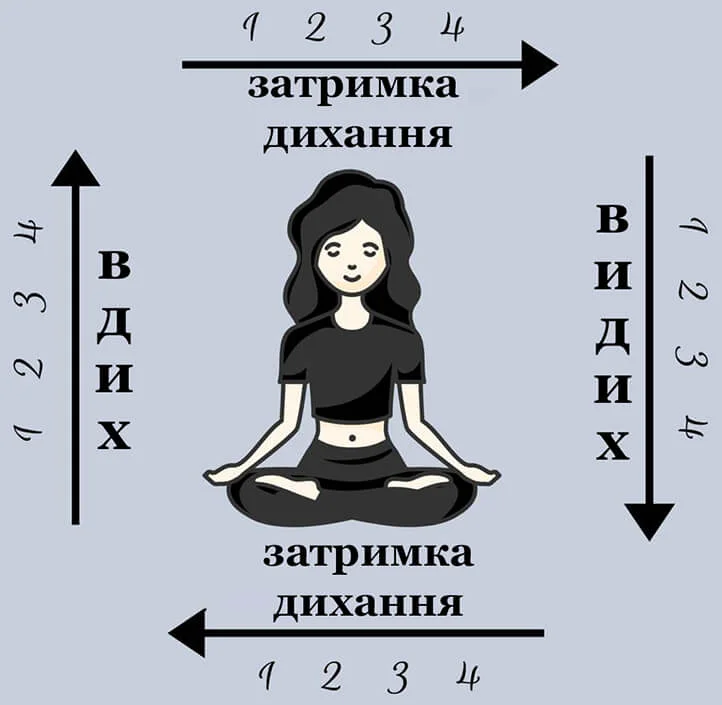In today’s fast-paced reality, filled with constant stress, deadlines, and information overload, it’s crucial to know how to maintain mental and physical balance. One of the most effective yet simple ways to relieve tension and restore balance is Box Breathing—a technique rooted in ancient yogic tradition thousands of years old.
Though Box Breathing may seem too simple at first glance, it has proven its effectiveness in combating stress, anxiety, and other psychological issues in modern life. By combining controlled rhythmic breathing with mindful presence in the current moment, this practice helps calm the mind and body, improve focus, and enhance overall well-being.
In this article, I will explore the scientific basis behind the benefits of Box Breathing, examine its numerous advantages, provide a step-by-step guide for proper practice, and discuss how to integrate this technique into your daily life for maximum benefit.

What is Box Breathing?
Behind the simplicity of Box Breathing lies a deep science based on the understanding of the connection between breathing, the mind, and the body. How we breathe directly affects our mental and physical state. Ancient sages and healers developed this technique to harness the power of conscious breathing to achieve greater balance and well-being.
Box Breathing is named for the four equal stages that make up one complete cycle. These four stages consist of inhalation, breath hold, exhalation, and another hold. Each stage lasts an equal amount of time, typically between 4 and 8 seconds.
Box Breathing Technique
- Inhale through the nose. The first stage of Box Breathing is a slow, deep inhalation through the nose. Try to fill your lungs as much as possible, keeping the breath smooth and calm. Counting to 4 (or longer, such as 6 or 8) helps control the pace.
- Hold your breath after the inhale. After completing the inhale, hold your breath, counting to the same number as for the inhale. This allows oxygen to distribute throughout the body and creates a moment of stillness between the inhale and exhale.
- Exhale through the mouth. The next stage is a slow, controlled exhalation through the mouth, lasting as long as the inhale. Visualize stress and tension leaving your body with each exhale.
- Hold your breath after the exhale. After exhaling, hold your breath again for the same count as the previous stages. This pause helps complete the cycle and prepares you for the next inhale.
The equal intervals for each stage are crucial as they create a rhythm that calms the mind and brings the body into a state of relaxation and mindfulness.

Benefits of Box Breathing
Thanks to its unique combination of controlled rhythmic breathing and mindful presence, Box Breathing offers a range of benefits for the mind, body, and soul. From reducing stress and anxiety levels to improving concentration and cognitive abilities, the benefits of this ancient practice extend far beyond simple relaxation.
Recent scientific research continues to reveal new evidence of the potential of Box Breathing to improve emotional and physical health. Exploring its numerous advantages, it becomes clear why this practice, highly valued for thousands of years, remains popular in modern society.
Reducing Stress and Anxiety
One of the most widely recognized benefits of Box Breathing is its ability to calm and soothe. A 2017 study published in the Journal of Medical Internet Research found that regular Box Breathing practice significantly reduces stress and anxiety.
This effect is explained by the fact that Box Breathing activates the parasympathetic nervous system, which is responsible for relaxation and recovery. As a result, heart rate, blood pressure, and cortisol (the stress hormone) levels decrease.
Improving Concentration and Cognitive Function
Regular Box Breathing practice also enhances concentration and cognitive abilities. A 2018 study published in the Journal of Alternative and Complementary Medicine found that eight weeks of Box Breathing significantly improves attention and working memory.
This effect may be related to the activation of the prefrontal cortex, which plays a crucial role in cognitive control, planning, and decision-making. Additionally, focusing on the breath trains the skill of being present in the moment, which promotes improved concentration and mindfulness in everyday life.
Regulating Emotions and Improving Mood
Box Breathing is also one of the effective techniques for emotional regulation and mood improvement. A 2019 study published in the Journal of Positive Psychology found that practicing Box Breathing for just four days significantly boosts mood and reduces negative emotions.
These positive effects may be linked to the influence of Box Breathing on amygdala activity, which plays a key role in emotion processing. The breathing practice helps reduce excessive amygdala activation, contributing to better emotional regulation and greater emotional balance.
Enhancing Mindfulness and Awareness
Another remarkable benefit of Box Breathing is its ability to cultivate a state of mindfulness and awareness. Since this practice requires full presence in the current moment and focus on the breath, it teaches the skill of mindful existence.
A 2018 study published in the Journal of Health Education and Prevention found that regular Box Breathing practice over six months improves mindfulness, awareness, and stress relief.
The development of mindfulness offers numerous advantages, including enhancing emotional intelligence, increasing productivity, strengthening interpersonal relationships, and even slowing the brain’s aging process. Integrating Box Breathing into daily life helps cultivate these valuable qualities.
Potential Physical Benefits
In addition to psychological benefits, some studies indicate that Box Breathing positively impacts physical health. Although more research is needed to confirm these findings, existing data are promising.
- Lowering blood pressure. A 2015 study published in the Journal of Alternative and Complementary Medicine found that practicing Box Breathing helps reduce both systolic and diastolic blood pressure.
- Improving lung function. Another study published in 2019 in the International Journal of Chronic Diseases showed that Box Breathing increases lung capacity and improves airway function in patients with chronic respiratory diseases.
- Boosting the immune system. Some research suggests that Box Breathing may strengthen the immune system by improving the levels of anti-inflammatory compounds in the body.
- Reducing symptoms of depression. In a 2017 pilot study, participants with depression reported a reduction in symptoms after an eight-week Box Breathing program.
Although these results require further investigation, they highlight the potential of Box Breathing as a versatile tool for improving overall physical well-being alongside its psychological benefits.

How to Practice Box Breathing?
While the concept of Box Breathing may seem simple, proper practice is essential to achieving maximum benefits. As with any other skill, there are specific guidelines and techniques to help you master this ancient practice and integrate it into your daily life.
From creating the ideal environment to choosing the correct posture and breathing pace, each aspect of a Box Breathing session plays a role in determining the quality of your experience. By following step-by-step instructions from experienced practitioners, you can quickly master this powerful tool for stress reduction, concentration improvement, and achieving greater tranquility.
Creating a Favorable Environment
The first step to successful Box Breathing practice is creating a calm and comfortable environment. Find a quiet place where you will not be disturbed and eliminate any potential sources of irritation or distraction.
Some people prefer to practice Box Breathing outdoors, enjoying the fresh air and natural sounds. Others find a home setting more suitable for full relaxation. Regardless of the chosen location, ensure that it promotes calm and focus.
Choosing the Right Posture
Posture also plays an important role in Box Breathing practice. Ideally, sit upright with your legs uncrossed to facilitate deep inhalations and exhalations. You can sit on a chair or the floor, using a cushion to support your lower back and maintain stability.
If you prefer to lie down, make sure your back remains straight and your knees are slightly bent. Any comfortable posture will do, as long as it doesn’t restrict breathing or cause discomfort.
Focusing on the Breath
Once you’ve found the ideal environment and posture, it’s time to focus on the actual process of Box Breathing. Close your eyes to reduce visual distractions and direct all your attention to the sensations associated with breathing.
Inhale slowly and deeply through your nose, counting to 4 (or any number comfortable for you). Then hold your breath for the same count. Exhale through your mouth, following the same count, and again pause, holding your breath and counting to 4.
Try to visualize this square rhythm of inhale-hold-exhale-hold to help maintain an even pace. Pay attention to the sensations in your abdomen, chest, and nasal passages during each stage of the cycle.
Gradually Increasing Duration
For beginners, it is recommended to stick to a count of 4 seconds for each stage of Box Breathing. However, as you get used to the practice, you can gradually increase the duration, such as to 6 or even 8 seconds for each part of the cycle.
It’s important not to rush too quickly and to move at your own pace. Excessively deep breathing can cause dizziness or coughing, especially for beginners. Listen to your body and increase the duration only when you feel fully comfortable with longer Box Breathing cycles. Avoid pushing yourself too hard.
The transition to longer breath holds should occur gradually and smoothly. Remember that the main goal is for the practice to be pleasant and relaxing, not tiring or uncomfortable.
Choosing the Right Time and Duration
While Box Breathing can be practiced anytime you feel the need, it’s helpful to set aside specific time for regular practice. Many people prefer to start their day with a few cycles of Box Breathing to set the tone for the workday. Another popular option is to practice Box Breathing before bed to calm the mind and body after a busy day.
But regardless of the time you choose, try to make the practice a daily habit. As for the duration, it is recommended to start with short sessions of 5-10 minutes. As you get used to it, you can gradually increase the practice time to 20-30 minutes or even longer.
Remember, there is no right or wrong time or duration to practice. The most important thing is to find a schedule that works for you and stick to it as consistently as possible.
Using Guides and Apps
Some people may find it helpful to use guides, videos, or apps to help them practice box breathing, especially in the beginning stages. These resources provide visual or audio guidance for each stage of the cycle, helping to maintain the correct rhythm and focus.
There are many free box breathing apps available for both iOS and Android. Some popular examples include Box Breathing, Inhale, Calm, and Balance. These apps often offer different length options and even relaxing nature sounds to create a calming atmosphere.
There are also many video guides with visual cues available on video streaming platforms like YouTube.
Whether you use guides or prefer to practice on your own, the key is to find an approach that works best for you and your lifestyle.

Integration into Daily Life
While a dedicated daily practice of box breathing is crucial for gaining maximum benefits, there are also numerous ways to integrate it into your everyday life. Using box breathing in daily situations can help you manage stress, stay focused, and maintain an overall sense of balance and mindfulness.
Application in Stressful Situations
One of the most obvious applications of box breathing is using it as a tool to reduce stress in tense situations. Imagine standing in a long line, running late for an important meeting, or facing an unexpected problem at work. Instead of letting your anxiety build up, take a moment and perform a few cycles of box breathing.
This simple practice will help you calm down, regain mental clarity, and better cope with the situation. You can practice box breathing anywhere. Just focus on your breathing instead of the source of stress.
Preparing for Important Events
Box breathing is also a powerful tool for preparing for important events, such as interviews, exams, presentations, or public speaking. Performing a few cycles beforehand can help you calm down and focus, reducing anxiety and nervousness.
Many athletes and performers use box breathing as part of their pre-performance routine to enter an optimal state of focus and calm before performing. Regardless of the situation, this practice can become your secret weapon against stress and anxiety.
Combining with Meditation
Box breathing and meditation complement each other perfectly. Doing a few cycles of box breathing before meditation helps calm the mind and prepare for a deeper meditative state.
Additionally, during meditation itself, you can use box breathing as an anchor for focusing your attention. If you get distracted, simply return your focus to your breathing and the four-part rhythm of inhale-hold-exhale-hold.
Daily Reminders
To maintain the habit of practicing box breathing and integrate it into your daily life faster, it’s best to set daily reminders. Use alerts on your phone, computer, or even physical notes to remind yourself to take a break and complete a few breathing cycles throughout the day.
Many people practice box breathing during short work breaks, before meals, or while waiting in line. Even a couple of minutes of this practice will help you restore calm, relieve tension, and shift your focus.
Involving Family and Friends
Another way to integrate box breathing into your daily life is to involve family members and friends. Make breathing exercises a shared activity aimed at improving well-being and strengthening connections.
Try starting your morning with a few cycles of box breathing with your family. This can become a calming ritual that helps everyone approach the day with mental clarity and positivity.
Organize “breathing meetups” with friends to practice box breathing together. You can discuss your experiences, give each other feedback, and motivate each other for regular practice.
By the way, involving children in box breathing will certainly yield results. This practice will teach them to manage stress, improve mindfulness, and enhance emotional regulation. Therefore, I recommend making box breathing a part of your family tradition and daily habits.
Using While Traveling and on Vacation
Box breathing can be especially helpful during travel or vacations. A change in environment and routine often leads to increased stress and anxiety, which can prevent complete relaxation and enjoyment of your time off.
Include box breathing in your travel routine to maintain a sense of calm and mindfulness, despite the changes. Practice it while waiting at the airport, in a hotel room, or even on the beach while listening to the sound of the waves.
Using this breathing practice as a relaxation tool during vacations will allow you to fully enjoy the time away and return home refreshed and revitalized.
Maintaining a Routine for Habit Formation
No matter how you choose to integrate box breathing into your life, it is important to stick to a certain routine to form a lasting habit. Studies show that it takes an average of about 66 days to form a new habit.
So be patient and don’t expect immediate results. Continue practicing box breathing daily, even if it initially seems like it’s not yielding noticeable results. Over time, it will become second nature, and you will begin to notice its positive impact on your mental and physical well-being.
Integrating box breathing into daily life is a gradual process that requires dedication and consistency.

Conclusion
Box breathing is an ancient technique that has proven its relevance in today’s world, filled with stress and endless distractions. From reducing anxiety and depression levels to improving focus, emotional regulation, and overall well-being, the benefits of this practice are truly impressive.
One of the most appealing aspects of box breathing is its accessibility and simplicity. Regardless of age, profession, or lifestyle, this technique can easily be integrated into your daily routine. All it takes is a little time, patience, and focus.
Moreover, box breathing requires no special equipment or expenses. Your body and breath are the only necessary tools to reap all its benefits. This makes it accessible to anyone looking to improve their well-being and quality of life.
Box breathing is rapidly gaining popularity around the world as more people become aware of its advantages. Join this growing movement and become part of a community that values simple yet powerful tools for improving personal well-being.
Share your box breathing practice experience with friends and family, involve them in this activity. Create support groups or join existing online communities to motivate each other and exchange tips.
Remember, you are not alone in your quest for greater calm and focus. Box breathing is a universal practice available to everyone.
So why not start today? Dedicate a few minutes to this ancient breathing technique and feel how it transforms your life. Learn to use this simple yet powerful tool to withstand the stresses of modern life and find harmony.




